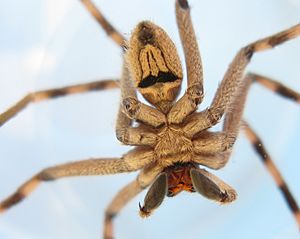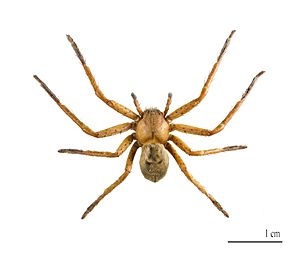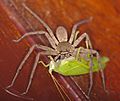Huntsman spider facts for kids
Quick facts for kids Huntsman spider |
|
|---|---|
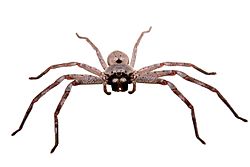 |
|
| Huntsman spider | |
| Scientific classification | |
| Kingdom: | |
| Phylum: | |
| Class: | |
| Order: | |
| Section: |
Entelegynae
|
| Superfamily: |
Sparassoidea
|
| Family: |
Sparassidae
Bertkau, 1872
|
| Genera | |
|
Delena |
|
| Diversity | |
| 82 genera, 1009 species | |
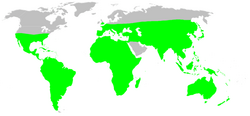 |
|
Huntsman spiders are a type of spider known for their large size. They belong to the family Sparassidae. People sometimes call them "giant crab spiders" because of how their legs are shaped. Bigger ones are also known as "wood spiders" since they often live in forests or woodpiles.
You can find Huntsman spiders in many warm places around the world. They live in Australia, New Zealand, South Africa, and Southeast Asia. They are also found in the Mediterranean region, Florida, and Hawaii. Some have even been seen as far north as England, Sweden, and Wales.
Unlike many other spiders, Huntsman spiders do not build webs to catch their food. Instead, they actively hunt for their meals. They mostly eat insects and other small invertebrates.
Contents
What Do Huntsman Spiders Look Like?
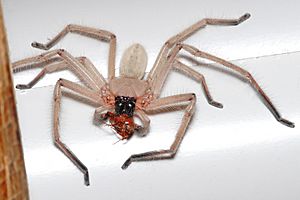
Huntsman spiders have eight eyes, arranged in two rows of four on the front of their head area. Many species can grow very large. For example, some male giant huntsman spiders in Laos can have legs that spread out up to 25–30 centimeters (about 10-12 inches)!
People sometimes confuse large Huntsman spiders with tarantulas. However, you can usually tell them apart by their legs. Huntsman spider legs are twisted, making them extend forward in a way that looks a bit like a crab.
Colors and Markings
The top side of Huntsman spiders is usually brown or grey. This helps them blend in with their surroundings. However, many species have bright markings on their undersides. These can be black and white, or have reddish patches near their mouth. These colors are a warning to predators.
Their legs have noticeable spines, but the rest of their body is covered in smooth fur. Huntsman spiders often hide under rocks, bark, or other shelters. You might also find them in sheds, garages, or other quiet places around homes.
The banded huntsman (Holconia) is a large spider. It is grey to brown with striped bands on its legs. The badge huntsman (Neosparassus) is even bigger, brown, and hairy. The tropical or brown huntsman (Heteropoda) is also large and hairy. It has mottled brown, white, and black markings.
Huntsman spiders do not have excellent eyesight like jumping spiders. Still, their vision is good enough to spot people or other large animals from a distance.
Are Huntsman Spiders Dangerous?
Like most spiders, Huntsman spiders use venom to paralyze their prey. They have been known to bite people if they feel threatened. However, they are generally not considered dangerous to healthy humans. Many people actually see Huntsman spiders as helpful. This is because they eat insect pests like cockroaches and crickets.
Some people have reported bites from different types of Huntsman spiders. The effects can include swelling and pain where the bite happened. Sometimes, people might feel sick, have a headache, or an irregular heartbeat. These stronger reactions are rare and usually happen with severe or repeated bites.
It's not always clear why a Huntsman spider bites a person. However, female spiders are known to protect their egg sacs and young very aggressively. Most bites seem to happen by accident, like when someone unknowingly handles a spider. Bites from Huntsman spiders usually do not require a trip to the hospital. There have been no reports of serious tissue damage from their bites.
How Huntsman Spiders Communicate
Male Heteropoda venatoria spiders, a type of Huntsman spider, have a special way to find a mate. When they sense a chemical signal (called a pheromone) left by a female, they make a unique sound. They firmly attach themselves to a surface. Then, they use their legs to send vibrations from their bodies into that surface.
Most of the sound comes from strong vibrations of their abdomen. The specific sound and pattern of vibrations tell females that a male of their species is nearby. If a female is interested in mating, she will then approach the male.
Images for kids
-
A Huntsman spider (lower) coming out of its old exoskeleton (upper).
-
A female Heteropoda venatoria eating a katydid.
See also
 In Spanish: Esparásido para niños
In Spanish: Esparásido para niños


